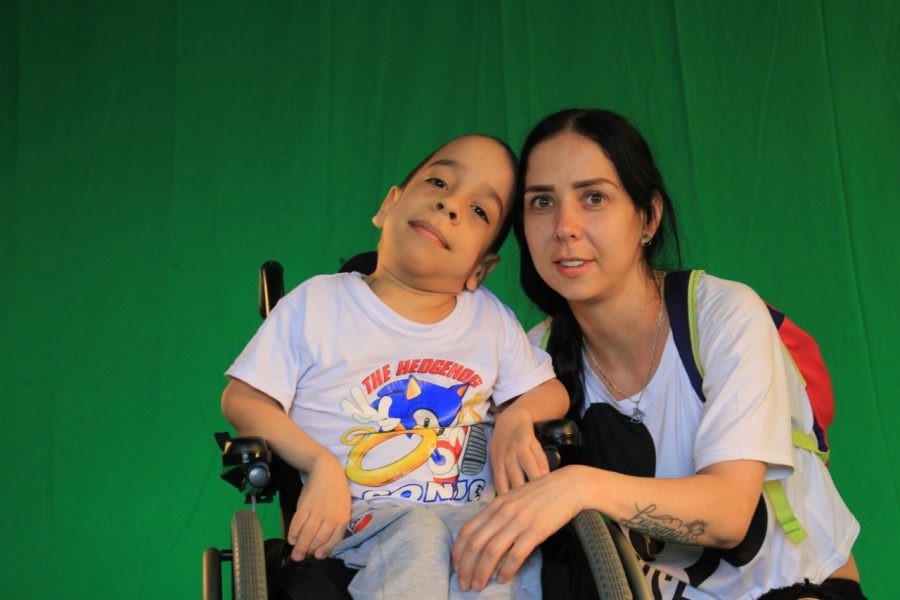TOM, Improving Lives
TOM participant Matias Rodriguez and his mother, Elizabeth.
He is shy under pressure but really fun to be around when relaxed. He likes watching TV, youtube videos, playing, and hanging out with his younger sister. People who get to know him also know that he is really smart and then he truly is like any other kid. When people look at him they only see him as a boy with a disability, but there is so much more to him than just a limitation.
Matias Rodriguez is an 8-year-old Colombian who was born and raised in Medellin. Matias was born with arthrogryposis congenita. Multiple joints in the body constrict as a result of this condition, and the person may be unable to completely extend or bend.
TOM is the acronym for Tikkun Olam Makers. It is a global movement whose objective is to enable people to volunteer and help persons with disabilities; among those that aided Matias was a group of them. Those that assist are known as makers, and include artists, designers, developers, engineers, and anybody who enjoys creating. From October 3-5, 2019, a group of makers at the annual TOM event at The Columbus School, developed a prototype of a device to assist Matias dress himself.
“Mati is a very happy and intelligent boy. His grandmother, who is his support in life, has helped him a lot to reach levels of independence with therapy support, emotional support. I think he will be a completely independent child for all his activities,” Maria Camila Alzate, leader in Matias’ TOM group, said.
Matias was born with congenital arthrogryposis, a disorder that may affect a person while they are still in the womb or after they are born. His family has always been there for him, especially his grandma, who is his main source of support.
“Mati was born with a congenital arthrogryposis condition. Arthrogryposis is a neurological and central nervous system disorder that makes muscular development challenging. It isn’t an illness at all. He’s going to have a hard time with a number of things. Matias is a little boy who, despite his age, requires a significant lot of help to carry out his daily activities,” said Alzate.
Alzate and her coworkers sought to assist Matias with his impairment while ensuring that it did not interfere with his regular activities. Despite the fact that having a disability typically means being dependent on someone or something, many people aspire to be self-sufficient. This was Matias’ freedom, even if it wasn’t a huge one for others: the ability to change or put on his own clothes.
“It was a simple construction with some fittings where items like shirts could be placed. Matias inserted his hands and head through the shirt’s hole and, using his strength, pushed the shirt out of the hole with his head, allowing him to put it on by himself,” Alzate explained.
This model that they built for him had 2 hooks, Matias would put the hem of the shirt on those hooks and he would either pull to take his shirt off and it would also help him to put his shirt on. Doing this simple task without help was a big step, since because of his condition he didn’t have enough strength to do it independently.
Whether it’s due to building, planning, or conflict, every TOM project has its unique set of obstacles.
“The issue with Matias was that there was no related system that could achieve what he desired. There existed some technology, such as robots, that could help him dress and even dress him on its own, but that was not the project’s purpose. Because we practiced a lot of stuff with Matias, and he was a youngster who was ready to accomplish something, it was a bit complex, but there was a time where he grew dissatisfied,” Alzate said.
The development process was a challenge since the goal was to create something that could help Matias, but not be invasive with his life. Matias was frustrated by this process because in the beginning the group couldn’t think of anything that could accomplish all of their standards.
After they thought of the idea and picked the project, they were able to assess whether or not they should use the prototype in his life in a way that he would like. So they constructed him a new bed, swapping his old bed for a firefighter’s bed because he adores firemen, and they also built the structure in the ‘truck’s command control room.’ But it’s no longer only functional; it’s also entertaining, and he wasn’t the only one who thought so.
“It was a solution that worked and that he was going to have fun using it,” Alzate said.
Working with someone as inspiring as Matias and witnessing how he overcomes obstacles in his everyday life despite his impairment was very motivating for the group.
“There are a lot of things to think about, but the most important is that less is more. Mati and I considered a number of systems, but the simplest solutions, in my view, are the best. As the adage goes, less is more, and simple solutions might be more practical than intricate ones. I also learnt the value of perseverance, and I was on the verge of giving up since we couldn’t find something suitable for Matias, but I continued. I was looking for help and considered other options because I feel I would have given up easily if it hadn’t been for him,” Alzate explained.
Work Cited
“Arthrogryposis.” Johns Hopkins Medicine, https://www.hopkinsmedicine.org/health/conditions-and-diseases/arthrogryposis
“TOM Colombia.” Tom, https://www.col.tomglobal.org/




